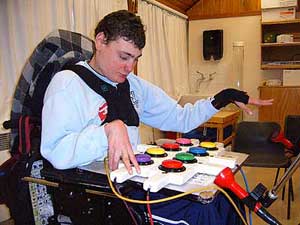 WHAT
IS SOUNDBEAM? WHAT
IS SOUNDBEAM?
The composer Edward Williams is responsible for development of Soundbeam,
the ultra-sonic distance-to-MIDI converter which enables movements,
at a distance and without physical contact to 'play' electronic
musical instruments. One of its more remarkable features is that
many, young and old, with various forms of disability, can now make
music in this way too - often leading to noticeable increases in
their physical or intellectual skills. Soundbeam's potential is
currently being extended (by Brian Johnson) to include the use of
light-related sensor technology.
Soundbeam was originally conceived as an esoteric
performance tool for professional dancers; the recognition of its
significance in the special education and therapy fields is a user-led
phenomenon.
Soundbeam provides a medium through which even
profoundly physically disabled or learning impaired individuals
can become expressive and communicative using music and sound. The
sense of control, agency and independence which this provides can
be a powerful motivator, stimulating learning and interaction in
other areas. Soundbeam is identified as a key resource by the Qualifications
and Curriculum Authority in assisting children with learning disabilities
to attain learning targets as prescribed by the National Curriculum
for Music. Its success rests upon two factors: the sensitivity of
the beam means that even the most unreachable or immobilised individuals
can ‘play’ independently; secondly, electronic technology
makes available a huge palette of possible soundworlds, releasing
the player from the traditional limitations of percussion-based
activity.
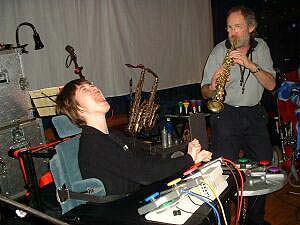 Soundbeam
works by sending out an ultrasonic ray which can be varied in length
from a few inches to several metres. It converts information about
movement and distance into a language called MIDI - an electronic
code which is used to send instructions to electronic instruments. Soundbeam
works by sending out an ultrasonic ray which can be varied in length
from a few inches to several metres. It converts information about
movement and distance into a language called MIDI - an electronic
code which is used to send instructions to electronic instruments.
"A Soundbeam is an invisible elastic keyboard,
in the air, but it's a keyboard that you can adjust; it doesn't
have all the notes all the time and it isn't necessarily one sound
all the time, or necessarily one size - so it can have one note
and be tiny or it can have 64 notes and be 6 metres long! - or 64
notes and be 43 centimetres long - you know it can have anything
you want in it, but the important thing is that you have to move
within it and the better your quality of movement within it the
more beautiful the music's going to be because that's always been
the case with music. You have to programme what notes are in the
beam, programme the articulation and the articulation is a very,
very powerful part of Soundbeam, because it allows you to play up
and down the beam, in and out of the beam, start and and stop sounds
in the beam, lots of very sophisticated playing techniques for the
beam which really have to be taught - but, having said that, certain
disabled people play it with an intuitive understanding which defies
belief - they seem to know how it works, which is marvellous."
(David Jackson)
What are Soundbeam's applications?
- can offer an expressive medium, giving motivation to move, to
compose, to explore movement and sound;
- can be tuned to respond to the tiniest gestures or the most sweeping
movements, so that a really broad range of ability/mobility can
be accommodated;
- is excellent for simple cause and effect work, giving an experience
of control which can help to establish the basic building blocks
of learning;
- can assist with the delivery of the National Curriculum and be
used for ambitious composition and performance projects;
- has a spectrum of applications that makes it ideal for inclusive
activities.
David Jackson's Jellybean Eye is his ingenious
switching system that enables up to eight people (who may have disabilities)
to access eight different instruments in one go.
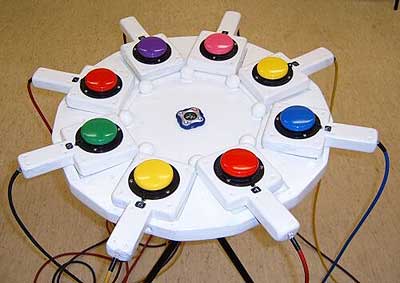
The Jellybean Eye
David Jackson suggests you choose from the following
activities and skills:
Soundbeam
Training
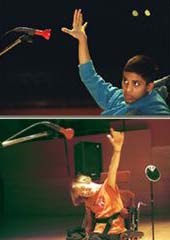 Soundbeam
Awareness Day: an introduction day for teachers, support
staff, parents, families, music students, and other practitioners
- to the amazing possibilities of David Jackson, his music and his
Tonewall. (Soundbeams, Jellybean Eye and Echo-Mirrors) Soundbeam
Awareness Day: an introduction day for teachers, support
staff, parents, families, music students, and other practitioners
- to the amazing possibilities of David Jackson, his music and his
Tonewall. (Soundbeams, Jellybean Eye and Echo-Mirrors)
Tonewall in School: a ‘blow them away-day
‘full of interactive workshops and/or concerts using full
interactive Tonewall rig. This is suitable for Special and Mainstream
Schools (adapted to age and ability). It could act as a first introduction
to Soundbeam - or be thematic and act as a pointer to the wider
future possibilities. This day can include a twilight session for
staff, parents, & governors.
Soundbeam Rig Design and Build: David is an independent
consultant. He can find the best, most ergonomic and economic solutions
to all your Soundbeam Rig problems.
Tonewall Master Classes:
1. ‘Soundbeam in Performance’ - join David working with
a wide range of physically disabled children - preparing for a concert.
2. ‘Soundbeam and Dance’ - join David working with top
Soundbeam choreographer Den Roper with mainstream and/or special
kids in the creation of new work.
3. ‘Composing with Soundbeam’ - bring your musical and
conceptual ideas to see and hear them rapidly take shape and form.
Afterwards, ship them home in your Soundbeam2!
Tonewall in Concert: a full blown solo Concert
with the ‘Sax and Soundbeam Maestro’ - a one man band
like you never imagined possible. Various DVDs available!
Major Works
for Combined Forces
"Marvellous; a great day for music!"
Andy Baker - Bournemouth Symphony Orchestra
"One of the most absorbing and convincing
dialogues that I've heard between man and machine."
Chris Blackford - The Wire
"We are marvelling at your ability to bring
the best out of everyone. You turned our youngsters into stars and
gave them a tremendous sense of pride, worth and self-belief."
John Sweeting - Chief Executive, Treloar Trust
"Original, captivating and professional."
Barnardo's High Close School, Wokingham
TRAINING "School for Soundbeam" Project
at Meldreth Manor School - declared outstanding by OFSTED
Tonewall - featured in The Times Interface, The
Independent & The Guardian; BBC, ITN, CNN & NBC TV NEWS,
Tomorrow's World; Radio 1 - Newsbeat, Radio 3 - Music Matters &
Radio 4
Education Matters and You & Yours.
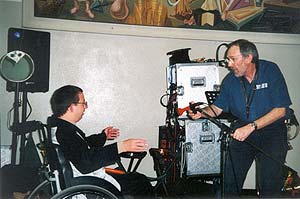
DAVID JACKSON'S TONEWALL: TOOLS OF THE TRADE...
SOUNDBEAM 1 & 2 - Invisible
e-l-a-s-t-i-c keyboards in the air...
JELLYBEAN EYE - Jackson's totally
revolutionary new Switching System allows up to 8 performers to
become an orchestra, rock band or simply the notes of scale.
ECHO-MIRRORS - The famous digital
sound effects for stunning voicework or sampling.
BAGS OF PERCUSSION - Fascinating
hand-held musical instruments from around the world.
...and of course the remarkable VdGG saxophones!
TONEWALL requires a space of 4 x 2 m for
equipment,
plus a minimum interactive space 4 x 2 m
SOUNDBEAM
OFFICIAL SITE

|